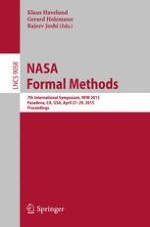This book constitutes the refereed proceedings of the 7th International Symposium on NASA Formal Methods, NFM 2015, held in Pasadena, CA, USA, in April 2015.
The 24 revised regular papers presented together with 9 short papers were carefully reviewed and selected from 108 submissions. The topics include model checking, theorem proving; SAT and SMT solving; symbolic execution; static analysis; runtime verification; systematic testing; program refinement; compositional verification; security and intrusion detection; modeling and specification formalisms; model-based development; model-based testing; requirement engineering; formal approaches to fault tolerance; and applications of formal methods.
